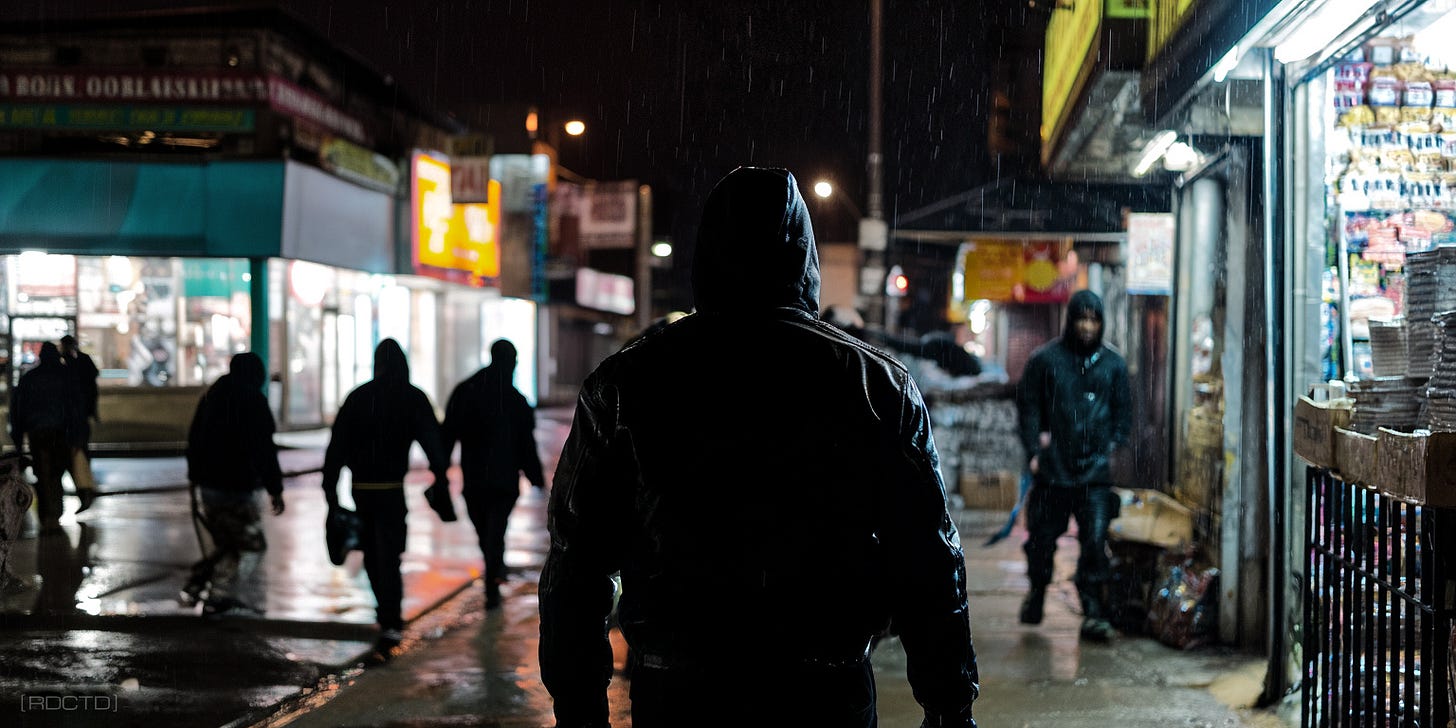A CIA Lesson in Street Smarts on the Move
Operational but Practical Urban Logistics.
Street smarts is strategy on the move: the disciplined habit of turning what you see, hear, and feel into actionable information or immediate action while you’re still in motion.
The street doesn’t pause. It edits you as you walk, and an operative adapts mid-sentence. This is tradecraft translated into motion. Read the light, the faces, the angles, then act before the scene resets.
The streets never stop to accommodate your plan or situation. It demands you build a mental model and keep editing it as reality keeps redrawing the map while you’re already moving.
An operative treats the sidewalk like a shifting chessboard where pieces appear, vanish, and change value by the second. You’re constantly sampling the scene - angles, crowds, and incentives - so the picture updates before you commit.
A plan that worked yesterday can die at the next corner because the crowd density, lighting, or the motives of people nearby just shifted. That’s why tradecraft favors modular moves over rigid scripts, leaving you room to branch without broadcasting the pivot.
Strategy here isn’t a document, it’s a living loop; perceive, decide, act, revise. Spinning fast enough to stay ahead of small problems before they grow teeth.
When you can keep that loop alive on the move, the street stops being chaos and starts becoming terrain you can read and shape.
Strategy is choices arranged in time, street smarts is arranging time itself.
Mobility reshapes the kind of intelligence that actually matters.
When you’re moving, information decays by the block, so you prioritize signals that refresh your map in real time. Baselines of behavior, where sight lines open and collapse, which doorways offer cover, which vendors are fixtures versus drifters.
You’re also watching the rhythm of the street. Who sets the tempo, who resists it, and where that friction pools.
Street smarts is catching a delivery truck double-parked and instantly re-drawing your route, it’s hearing a scooter’s approach before you see it, it’s using window glass as a rearview to expand your arc without telegraphing interest.
An operative reads micro-cues like shifting body orientation, stalled conversations, or a sudden lull in vendor chatter that says “something just changed.”
You’re filtering hard - discarding static, weighting fresh, and letting older assumptions expire before they trap you. In covert operations this is ‘ambient collection’, low-signature sensing that feeds decisions without flagging attention.
Street smarts is adapting faster than the environment can shift against you.
Strategy on the move also lives or dies by tempo.
Control tempo to control choices. Lose tempo, and the environment starts choosing for you. A slow drift through a market lets you blend and harvest detail. A burst of pace at a choke point can break a tail or carry you through before attention locks.
Urban spaces keep their own metronome - lights cycling, buses kneeling, security rounds - and if you can hear that beat, you can step between notes.
The point is calibrate timing to the street’s rhythm, speed is secondary albeit always critical.
Good street smarts means knowing when to be early, when to be exactly on time, and when to be fashionably late because the crowd will hide your transition.
Use cover actions (examining a menu, tying a shoe, answering a text) to modulate pace without signaling that you’re maneuvering.
Tempo is how you widen your decision window or compress someone else’s. You don’t fight the flow; you ride it until it delivers you where you need to go.
Street smarts is turning instinct into strategy and strategy into reflex.
Adaptation beats perfection.
Static plans tend to shatter on first contact, modular plans flex. An operative carries options that stack easily - two or three pretexts that fit the environment, a handful of exits pre-seen, a reversible first move that doesn’t burn the rest.
Pack your plan with breakpoints. Moments where you can pause, re-scan, and choose the next branch without telegraphing indecision. Think “branch and sequel”: if A happens, pivot to B; if B stalls, you’ve already prepared C without advertising the shift.
Option value’s your safety net, so you keep one spare route and one spare story in reserve.
Street smarts is the discipline of never letting your next move be your only move. In tradecraft terms, you operate like a climber placing protection as you ascend: if one hold fails, the whole climb doesn’t.
Baseline first, interpret second, act third.
Strategy isn’t just outmaneuvering, it’s stewardship of risk and second-order effects.
On the move, your choices ripple into crowds, bystanders, teammates, and sometimes people you’ll never meet.
Street smarts means you favor de-escalation over display, take the quieter exit instead of the clever confrontation, and leave room for others to keep their day intact.
In tradecraft terms, think proportionality, necessity, and reversibility before you commit. If a move closes more futures than it opens, it’s the wrong move even if it “works” in the moment.
Build contingencies that fail soft, not loud, and rehearse the non-heroic option first. The best operations are the ones nobody notices because nothing dramatic happened, just clean decisions that widened options and minimized footprint.
Street smarts is policy written at walking speed.
Street smarts is composure in motion.
Your pulse wants to sprint, but your thinking has to glide.
You manage that gap with small, reliable tactics; steady nasal breaths, a soft scan of near-to-far sight lines, and micro-pauses masked as cover actions - checking a watch, tying a shoe, adjusting a strap.
The operative who can breathe, shrink their signature, and keep curiosity switched on while moving through uncertainty will see more, decide cleaner, and leave fewer fingerprints.
Build an internal metronome that syncs to the street’s rhythm so you’re choosing moments instead of being chosen by them.
Use anchors; touch the watch crown, note three sounds, name one objective - to reset without breaking stride.
Strategy that can’t move isn’t strategy, it’s a wish. The street rewards a mind that’s light on its feet, ruthless about reality, and gentle in its touch.
That’s tradecraft you can run anywhere, whether you’re easing through a checkpoint abroad or cutting across your own city at rush hour.





One of the best pieces there that explains the fluidity of events.
Most important: The street *remembers.* You have to be attuned to just how you present to others every time you reenter the outside world. If you slip, it will be noted. Some people just watch the faces/bodies on their block all day long. It is all they talk about. Some are paid to do this. Most are just living their lives. But everyone sees you, and everyone will remember if you were tested and failed. You will be tested. It is not if but when. Make sure you are remembered positively.
Thanks so much for all you do. Appreciate it. +1